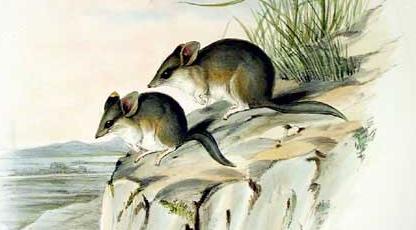|
| 질의: Fat-tailed dunnart | 결과: 1번째/4 | |
Fat-tailed Dunnart (Sminthopsis crassicaudata) - Wiki
| 제목: | Fat-tailed Dunnart (Sminthopsis crassicaudata) - Wiki
| |

| 해상도: 416x230
파일크기: 17606 Bytes
등록시간: 2007:08:10 15:20:08
|
Fat-tailed Dunnart
From Wikipedia, the free encyclopedia
[Photo] Sminthopsis crassicaudata (orig. Podabrus crassicaudatus)
Source John Gould, F.R.S., Mammals of Australia, Vol. I Plate 47, London, 1863. http://www.museum.vic.gov.au/bioinformatics/mammals/images/Pod_cras Date 1863. Author John Gould http://commons.wikimedia.org/wiki/John_Gould
The Fat Tailed Dunnart (Sminthopsis crassicaudata) is a species of mouse-like marsupial of the Dasyuridae family, the family includes the Little Red Kaluta, quolls, and the Tasmanian Devil. It has an average body length of 60-90 mm with a tail of 45-70 mm. Ear length is 14-16 mm. Its weight varies between 10-20 grams, it is one of the smallest carnivorous marsupials. The tail becomes fat a few mm from the anus and right up to the tip of the tail.
Distribution and habitat
The range of S. crassicaudata in Australia is in diverse habitats except for the Kimberley region of Western Australia and northern Northern Territory like Arnhem Land and Kakadu National Park, but avoids the Wannon and Mallee scrub habitats in Victoria. In the northeast of Victoria, the species can also be found in grassy woodlands and samphire shrublands. The subspecies S. c. crassicaudata is in the Epping Forest National Park in Queensland. S. c. ferruginea is found around Lake Eyre in South Australia (Finlayson, H.H. (1933)). S. c. centralis is found in Killalpannina (as Killalpanima, Lake Eyre East), SA.
The habitats in which the species can be found include sparse grasslands, open shrublands and farmlands where there is considerable bare land. The impact of unimproved farming has been positive for this species as the type of habitat created is suitable to this dunnart's requirements, but intensive agriculture is seen as a negative factor for the species.
Social organisation and breeding
This species breeds from July to February, with the young in the pouch from July to April (Morton 1978b). Gestation is for 13 days and the young remain in the pouch for 70 days with litter size on average 7.5 with a 33% infant death rate. They generally have 2 litters per year with females not breeding for the first year. The average life span of the females is 18 months, and males 15 months.
Diet
The Fat-tailed Dunnart's diet includes insects such as beetles, spider larvae, small reptiles, and amphibians. It stores fat reserves in its carrot-shaped tail for times of food shortage.
http://en.wikipedia.org/wiki/Fat-tailed_Dunnart
| The text in this page is based on the copyrighted Wikipedia article shown in above URL. It is used under the GNU Free Documentation License. You may redistribute it, verbatim or modified, providing that you comply with the terms of the GFDL. |
|
^o^
동물그림창고 똑똑전화 누리집
^o^
|
|